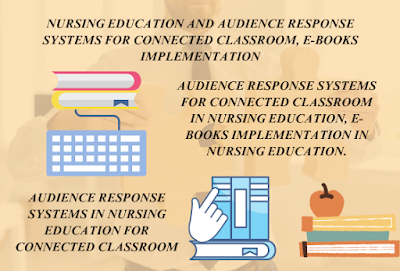The Audience Response Systems for Connected Classroom E-books Implementation In Nursing Education. E-books Implementation In Nursing Education In the evolving landscape of nursing education, integrating technology is becoming essential for fostering a more interactive and effective learning environment.
The Audience Response Systems for Connected Classroom E-books Implementation In Nursing Education
Two notable advancements are Audience Response Systems (ARS) and e-books. These tools offer innovative ways to engage students and streamline educational resources. Use of Audience Response Systems (ARS) or ‘clickers’ as an active learning strategy in nursing education has been steadily on the rise.
Audience Response Systems: Revolutionizing Classroom Interaction
Audience Response Systems (ARS), also known as student response systems or clickers, have transformed traditional classroom dynamics. These systems consist of a radio-frequency receiver connected to the instructor’s computer and individual transmitters for each student. When a question is posed, students submit their answers using these handheld devices, which are then collected and analyzed by the system.
Benefits of ARS in Nursing Education
- Enhanced Engagement: ARS fosters higher student participation by allowing immediate feedback and interaction (Klein & Kientz, 2013; Revell & McCurry, 2010).
- Anonymity: By providing an anonymous platform, ARS helps reduce the anxiety associated with answering questions in front of peers (Berry, 2009; Lee & Dapremont, 2012; Russell et al., 2011).
- Immediate Feedback: The system can display aggregated responses, which helps instructors gauge understanding and adjust teaching methods in real-time.
- Flexibility in Response Collection: Alternatives to traditional ARS include text messaging services, which are cost-effective and require no additional hardware. This method allows students to text their answers, creating a “word cloud” of responses that can visually represent class opinions.
Implementing ARS in the Classroom
To effectively integrate ARS, consider both electronic and low-tech methods. Traditional ARS requires specialized equipment and software, while paper-based systems involve students holding up colored cards to indicate their answers. Although low-tech methods are less complex, they are limited to basic question formats but provide a quick and effective way to gauge student understanding.
E-books in Nursing Education: A Digital Shift
The rise of e-books offers a modern alternative to traditional textbooks, with applications such as Amazon’s Kindle, Apple’s iBooks, and Barnes & Noble’s Nook leading the way. These digital resources are increasingly being adopted by nursing educators for their convenience and accessibility.
Advantages of E-books
- Portability and Convenience: E-books can be accessed on various devices, including tablets and e-book readers. They eliminate the need for physical storage and allow for instant access to educational material.
- Cost-Effectiveness: E-books often cost less than printed textbooks and e-book readers are generally more affordable than tablets (Abell & Garrett-Wright, 2014).
- Battery Life: Dedicated e-book readers like the Kindle and Nook have longer battery life compared to tablets, making them ideal for extended reading sessions.
Challenges of E-books in Nursing Education
- Limited Functionality: E-book readers typically offer a monochrome e-ink display, which may not be suitable for textbooks with color images or complex diagrams. Additionally, their slow processing speeds can hinder navigation and functionality.
- Screen Size and Navigation: Smaller screens can make it challenging to navigate through large textbooks, impacting the ease of use in a clinical education setting.
The Future of E-books
While e-books offer numerous benefits, their limitations mean that nursing educators may find greater flexibility with tablets and smartphones. Ongoing advancements in e-book technology, such as larger screens and enhanced color capabilities, may eventually make them a more viable alternative to traditional textbooks.
By leveraging Audience Response Systems and e-books, nursing educators can create a more dynamic and responsive learning environment. As technology continues to evolve, staying updated on these tools will be crucial for enhancing educational practices and meeting the needs of modern nursing students.
Read More:
https://nurseseducator.com/didactic-and-dialectic-teaching-rationale-for-team-based-learning/
https://nurseseducator.com/high-fidelity-simulation-use-in-nursing-education/
First NCLEX Exam Center In Pakistan From Lahore (Mall of Lahore) to the Global Nursing
Categories of Journals: W, X, Y and Z Category Journal In Nursing Education
AI in Healthcare Content Creation: A Double-Edged Sword and Scary
Social Links:
https://www.facebook.com/nurseseducator/
https://www.instagram.com/nurseseducator/
https://www.pinterest.com/NursesEducator/
https://www.linkedin.com/in/nurseseducator/
https://www.researchgate.net/profile/Afza-Lal-Din
https://scholar.google.com/citations?hl=en&user=F0XY9vQAAAAJ
